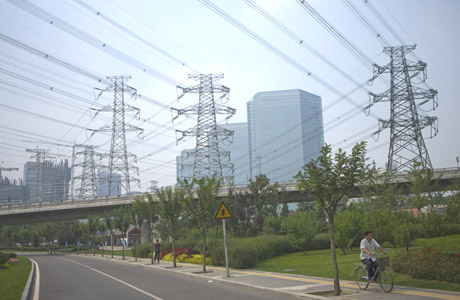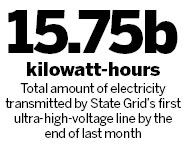Investment
State Grid unveils ultra-high-voltage power line plans
By Wan Zhihong (China Daily)
Updated: 2010-08-13 13:41
 |
Large Medium Small |
|
 A cyclist rides past electricity pylons in Beijing. State Grid Corp of China will build a network of ultra-high-voltage lines in northern, eastern and central China by 2015. Nelson Ching / Bloomberg
|
BEIJING - State Grid Corp of China, the country's major power grid operator, plans to build a network of ultra-high-voltage (UHV) power transmission lines by 2020, linking major energy production bases with the nation's power-guzzling regions.
Liu Zhenya, president of State Grid, said on Thursday that in order to improve the country's power transmission capacity, the company will complete the construction of a network of UHV lines in northern, eastern and central China during the 12th Five-Year Plan (2011-15).

UHV lines are able to send more electricity over longer distances more efficiently than conventional lines, said Liu. "The accelerated development of such projects fits well with the needs of China's power industry."
The capacity of UHV lines can reach as much as 1,000 kilovolts (kV). China's major power lines currently have a capacity of 500 kV.
Cross-province power transmission capacity in China is expected to exceed 400 million kilowatts (kW) by 2020. The development of UHV lines can help meet that target, said Liu.
Qian Zhimin, vice-administrator of the National Energy Administration, said that development of UHV lines can help the country better allocate its natural resources.
Most of the country's coal mines are located in northern China and a large part of the country's water resources are in southwestern regions. Power generated in these regions can be sent to the high energy-consuming eastern and southern regions more effectively through UHV lines, he said.
State Grid's first UHV line, with a capacity of 1000 kV, went into operation in January last year. It transmitted 15.75 billion kilowatt-hours (kWh) of electricity by the end of last month, according to the company.
The line, linking Shanxi, Henan and Hubei provinces, has a total length of 640 km.
The company's second UHV line, linking Sichuan province and Shanghai municipality, went on line in July this year.
The project is designed to send 32 billion kWh of hydro power to Shanghai annually. It is expected to save 25 million tons of carbon dioxide emissions annually.
Construction of UHV lines has evoked intense debate in the country. Some analysts said it is not worthwhile to build such projects, which are very costly.
State Grid said earlier it planned to invest 100 billion yuan ($14.7 billion) in building UHV projects over the next three to four years.
China Daily